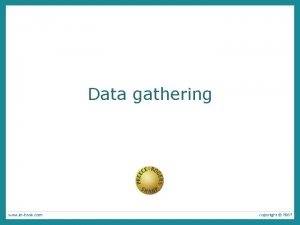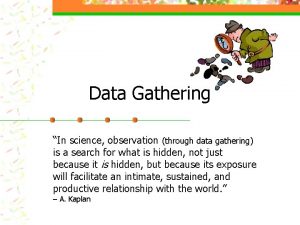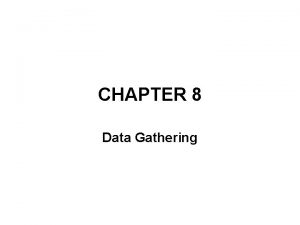7 1 4 Inquiry Gathering Data Data needs











- Slides: 11

7 -1. 4 Inquiry

Gathering Data �Data needs to be gathered more than one time under the same conditions and with the same measurement tools. �When possible, measurements should be taken several times, and then the results averaged. �Each set of repeated data is called a trial.

Gathering Data cont. �Repetition ensures that the experiment is valid and that the data is reliable. ◦ Validity indicates how close the investigation is to being accurate and dependable. ◦ As a result of validity, other investigations repeated the same way should produce similar results. �Qualitative data involves the five senses �Quantitative data involves numbers

Well- designed experiment (valid experiment) Includes �A control group �Multiple trials �A large sample size �A reproducible (able to repeat) procedure �Only one independent variable

Sample �Sample: a portion of the total number, as a type of estimation. �The sample is used to take a representative portion of the objects or population for research. �A poorly chosen sample size can be unrepresentative of the whole. �Careful observations made from a proper sample size result in information and conclusions that might apply to the whole population.

Repeat Experiments �Reasons why a repeated investigation could produce different results may be: ◦ The setup of the materials was not followed properly. ◦ Similar procedures were not followed in the exact same way. ◦ Appropriate tools were not chosen to complete the investigation. ◦ Tools were not used properly. ◦ Measurements were not taken accurately. ◦ Different observations were collected. ◦ Mistakes were made when recording data such as numbers written incorrectly.

Technological Design

Tech Design �Identifying a need �Researching the problem �Designing a solution �Building a prototype �Troubleshooting and redesigning �Communicating the results

Scientific Method Same or Different Technological Design Ask a Question Different Define the Problem Background Research Same Background research Construct a hypothesis Different Design Solution Experiment Different Build prototype Analyze data Different Troubleshoot and revise Communicate Results Same Communicate Results

Tech Design �Technology applies scientific knowledge in order to develop a solution to a problem or create a product to help meet human needs. �Technology is usually developed because there is a need or a problem that needs to be solved.

Tech Design � Steps in the technological design process include: � Identifying a problem or need ◦ Research and gather information on what is already known about the problem or need � Designing a solution or a product ◦ Generate ideas on possible solutions or products ◦ Evaluate the factors that will limit or restrict the solution or product design ◦ Determine the trade-offs of the solutions or products (what must be given up in order to create the solution or product) � Implementing the design ◦ Build and test the solution or product ◦ Identify any problems with the solution or product o If necessary, redesign the solution or product to eliminate any problems in the design � Evaluating the solution or the product ◦ Determine if the solution or product solved the problem o Identify the pros and cons of the solution or product
 Primary needs and secondary needs
Primary needs and secondary needs Satisfaction
Satisfaction Simple claustral complex
Simple claustral complex Strategic gender needs and practical gender needs
Strategic gender needs and practical gender needs What is target needs
What is target needs Is interviews qualitative or quantitative
Is interviews qualitative or quantitative Data gathering procedures example
Data gathering procedures example Apa itu data requirement gathering
Apa itu data requirement gathering Data warehouse requirements gathering
Data warehouse requirements gathering Data gathering procedure
Data gathering procedure 5 key issues in data gathering
5 key issues in data gathering Five key issues of data gathering
Five key issues of data gathering





















